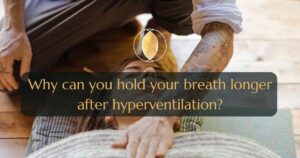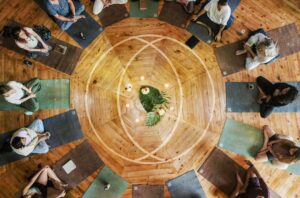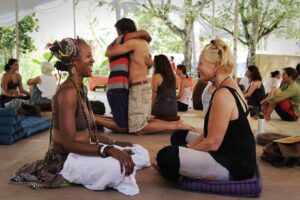“It is safe to breathe, it is safe to feel.” This is a reminder many Alchemy of Breath (AoB) facilitators give during a Breathwork session. What we don’t say is “hold your breath.” Unfortunately, however a couple of incidents have occurred recently where breathers chose to hold their breath at the end of a Breathwork and what happened was shocking. We couldn’t find any direct information or explanation for it online. So we did some digging and what we discovered is essential information that every breather and every facilitator should be aware of. So let’s dive in!
First a bit of background info. I am an AoB Breathwork facilitator and writer and about 6 weeks ago during a group Breathwork session a breather had what looked like a seizure at the end of the class. His face went blue, his whole body tensed up, his eyes glazed over, he had spit around his mouth, and he experienced temporary amnesia. When he came through he admitted he had purposefully held his breath at the end of the session and that’s the last thing he remembered. I sat with him an extra hour and he left feeling fine aside from being tired and a bit ungrounded.
A very similar episode happened a few weeks later with a gentleman who at the end when I advised him to begin breathing through his mouth, admitted he thought it would feel nice to hold his breath and went ahead and did so. I was holding space for a group of ten so I did not immediately notice and when I did, I went to his side, and he then had a similar seizure-like episode that lasted for about a minute.
Being the researcher that I am, I scoured the web looking for answers and was surprised to literally find nothing! In a way this is good news because it shows how extremely uncommon it is. However if it’s happened in my Breathworks, surely it’s happened to other breathers and other facilitators have witnessed it. When I brought this to the attention of the AoB team we felt it was important to find answers to what caused this and to raise awareness of the importance of not holding your breath during conscious connected Breathwork.
Conscious Connected Breathwork is Safe, Breath Holding During A Session Is Not!

Before you start fearing conscious, connected breathwork or thinking it’s unsafe please listen up! The conscious connected breathwork that AoB, Holotropic, Rebirthing and many other Breathwork schools are offering does not cause seizures. Also I am not a doctor and can’t officially say whether it was or wasn’t a seizure. What I discovered in my research is that oxygen deprivation from their breath hold likely led to severe hypoxia (oxygen deficiency in the tissue) which then triggered these episodes.[1]
The Scientific/Physiological Explanation
Conscious, connected breathing (CCB), is a form of mild hyperventilation, which causes your ph levels to rise and your CO2 (carbon dioxide) levels to drop. This is not problematic or harmful in and of itself, however carbon dioxide acts as the alarm bell that urges you to breathe.[2] So if you purposefully hold your breath after CCB you can hold it for longer, but your alarm bell that signals oxygen levels are dropping too low and you need to breathe may not go off. You may then reach severe hypoxia which is a condition in which the body is deprived of adequate oxygen supply at the tissue level.[3] The hypoxia can lead to a temporary hypoxic blackout, loss of motor control (LMC), or in severe cases a seizure, and this can happen without warning because the alarm bell is deactivated.[4],[5]
There is no research or terminology for blackouts or seizures caused by breath holding during CCB Breathwork likely because it’s rare and breath holding is not meant to be done during the CCB process. However it would most likely be classified as an anoxic seizure because anoxia happens when your body loses its oxygen supply and oxygen levels drop too low.[6] Anoxic seizures are common in young children and referred to as ‘breath-holding spells’ because it happens when they exhale and then hold their breath.[7], [8] This is also sometimes seen in free diving and referred to as samba, hypoxic fit, or LFC (loss of motor control).[9] [10] This is why free divers are told not to hyperventilate before diving, because it lowers CO2 and they risk having their alarm bell not go off and passing out or having a seizure under water.
Listen up Wim Hof Breath Holders
Both of my breathers that experienced this were physically healthy men, who also practiced Wim Hof, and admitted to holding their breath purposefully prior to the episodes. I don’t believe this is a coincidence! Although I am grateful for Wim Hof for helping to increase awareness of Breathwork and making it more mainstream, his approach is very accomplished based, and that can invite an egoic or forceful approach to Breathwork where you push yourself past your limits and fail to listen to the messages of your body.
Both breathers were breathing very deep and powerfully during the session and if you are trying to give it 110% instead of listening to the messages your body is giving you, you may push your CO2 levels unnecessarily low (and the CO2 as mentioned before is the alarm bell to breath). This plus the fact that Wim Hof breathwork teaches you to resist the urge to breath and be comfortable with the uncomfortable, means you could very easily miss the signal to breath or ignore it past the point of no return. So if during a CCB practice you get the idea “Ohhh it might feel nice to hold my breath here,” we strongly advise you to resist that urge!
Why can you hold your breath longer after hyperventilation?

When you hyperventilate, you can hold your breath longer because there is less CO2 than usual and not because there is more oxygen.
AoB Is Not About Forcing, It’s About Allowing
In Alchemy of Breath we are not forcing the breath or pushing our bodies beyond their capabilities we are allowing, not pushing. We are simply taking full body breaths, keeping the inhales and exhales connected and then allowing what wants to be seen, felt or heard, to arise. Breathing in this way is safe so long as you don’t have any preexisting medication conditions (in which case you should speak with your healthcare provider before attending a Breathwork session). Also worth noting, in AoB we encourage a passive and non-forceful exhale. We do this for two reasons – firstly because as mentioned above our intention is to allow and not to force anything; and secondly because exhaling more than you inhale will cause CO2 levels to drop further.
Note: Seizures Rarely Cause Lasting Harm
Worth noting, although they look scary from the outside, according to the Center for Disease Control (CDC) seizures rarely require medical assistance or cause any harm (especially if you are lying down already in a safe space) and almost 1 in 10 people will have one at some point in their life.[11] The only time it would be necessary to seek medical attention is if a seizure lasts more than 5 minutes, the person has difficulty breathing or waking after the seizure, there is a second seizure soon after the first, or the personal has a health condition such as heart disease, diabetes, or pregnancy.[12]

Closing Thoughts
During both of these situations I was able to remain surprisingly calm and had a deep inner knowing that everything was going to be fine. I credit the strong emphasis on the inner journey and on connecting to your felt sense (body intuition) that AoB places in the training for this. My feelings guided me on how to best support these gentlemen during and afterwards, and both walked away from the experience healthy and feeling safe and supported. AoB equips you to handle any situation that might arise with ease and grace and I am very grateful for that!
This is why schools that offer shotgun training over a week or a weekend should be avoided. You can learn the technique very easily, but until you have gone on your own deep inner journey you cannot safely and authentically support others on theirs. And Breathwork is deep work. We are working with trauma, and loss, and pain, and so many things can arise both emotionally and physically and you need adequate training to be prepared for this. If you are considering training to become a facilitator and would like to see a database of schools that have been certified by the Global Professional Breathwork Alliance (GPBA) you can find them here: https://breathworkalliance.com/certified-schools/
Finally, if you are interested in knowing more about Alchemy of Breath Academy, you want to join us at our Free Sunday #BreathetheWord Breathworks or you want to find out what makes us a world leader for Breathwork facilitation training you can get all the details here: www.alchemyofbreath.com.
PS Here Are Some Safety Tips for Facilitators
- Consider asking before the Breathwork if your breathers do Wim Hof or free dive and if they say yes, emphasize how important it is to not hold their breath during CCB because the reduced alarm bell in combination with their increased tolerance to holding their breath could cause them to miss the emergency signal that it’s time to breathe.
- Watch your breathers to make sure they are breathing throughout the session. Sometimes breathers stop breathing unintentionally, the experience in these moments is usually an experience of peace and unity. But that happens naturally and is very different than making a conscious decision to hold the breath. Use your felt sense and if you feel constriction or concern gently remind them to come back to the breath and use grounding touch if necessary.
- Look for a bluish color in skin, fingernails, and lips – this is a sign of hypoxia (low oxygen levels in the tissue) and you should encourage them to breath immediately and have them open their eyes and look at you if possible to follow your breath.
- The following are potential signs of a seizure: uncontrollable jerking movements, stiffening of the body, glazed over eyes, a staring spell, or rapid blinking; temporary confusion or loss of consciousness, drooling, slight foaming, or bubbling at the mouth, weird breathing or choking/gagging sounds, a lack of breathing, or a lack of responsiveness to noises or prompts.
- Know that seizures usually end on their own within a couple of minutes and rarely ever require medical assistance. However if any of the following apply, call 911 immediately: the seizure lasts more than 5 minutes, the person has difficulty breathing or waking after the seizure, there is a second seizure soon after the first, or the personal has a health condition such as heart disease, diabetes, or pregnancy.[13]
- If a seizure or blackout occurs the best thing you can do is remain calm and by the breathers side. Make sure there are no objects around them, take off their glasses if they are wearing any, and if possible roll them onto their side. Gently and calmly repeat to them “You’re okay, breathe, breathe, you’re safe.” Stay with the person until the seizure ends and he or she is fully awake. After it ends, help the person sit in a safe place. Make sure they are fully grounded before leaving the session and do not offer them water or food until they are fully alert.
[1] https://www.ncbi.nlm.nih.gov/pmc/articles/PMC6374628/
[2] https://journals.physiology.org/doi/full/10.1152/advan.00030.2015
[3] https://link.springer.com/chapter/10.1007/978-94-017-1828-8_1
[4] https://www.researchgate.net/publication/302442886_Hypoxic_Blackout_Diagnosis_Risks_and_Prevention
[5] https://wexnermedical.osu.edu/blog/what-happens-when-you-hold-your-breath
[6] https://pubmed.ncbi.nlm.nih.gov/11313215/
[7] https://pubmed.ncbi.nlm.nih.gov/11313215/
[8] https://clinicalgate.com/breath-holding-spells-and-reflex-anoxic-seizures/
[9] https://pubmed.ncbi.nlm.nih.gov/17024640/
[10] https://www.researchgate.net/publication/302442886_Hypoxic_Blackout_Diagnosis_Risks_and_Prevention
[11] https://www.cdc.gov/epilepsy/about/first-aid.htm
[13] https://www.cdc.gov/epilepsy/about/first-aid.htm





